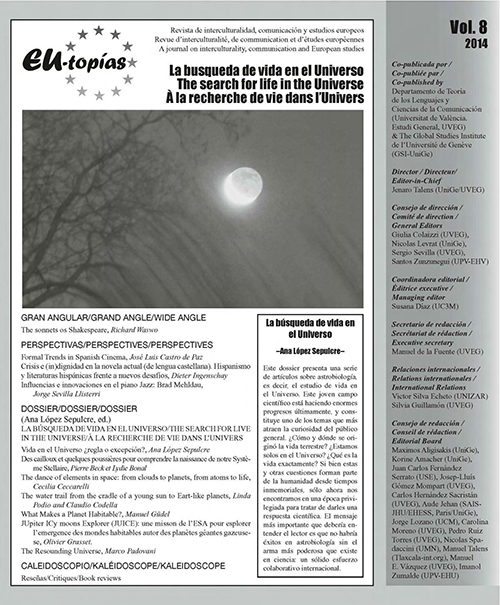What Makes a Planet Habitable?
DOI:
https://doi.org/10.7203/eutopias.0.18778Keywords:
Exoplanets, habitability, life Abstract
Abstract
Before life can form and develop on a planetary surface, many conditions must be met that are of astrophysical nature. Radiation and particles from the central star, the planetary magnetic field, the accreted or outgassed atmosphere of a young planet and several further factors must act together in a balanced way before life has a chance to thrive. We will describe these crucial preconditions for habitability and discuss the latest state of knowledge.
 Downloads
Downloads
 References
References
Feulner , Georg (2012) “The faint young Sun problem”, Reviews of Geophysics, 50, CiteID RG2006.
Elkins-Tanton , Linda T. (2008) “Linked magma ocean solidification and atmospheric growth for Earth and Mars”, Earth Planet. Sci. Lett., 271, pp. 181-191.
Grenfell , John L., et al. (2014) “Sensitivity of biosignatures on Earth-like planets orbiting in the habitable zone of cool M-dwarf stars to varying stellar UV radiation and surface biomass emissions”, Planet. Space Sci., 98, pp. 66-76.
Güdel , Manuel, et al. (2014) “Astrophysical Conditions for Planetary Habitability”. In Protostars and Planets VI, in press.
Kasting, James F. (1988) “Runaway and moist greenhouse atmospheres and the evolution of earth and Venus”, Icarus, 74, pp. 472-494.
Kasting, James F.; Whitmire , Daniel P.; Rey – nolds , Ray T. (1993) ”Habitable Zones around Main Sequence Stars”, Icarus, 101, pp. 108-128.
Kasting, James F.; Catling , D. (2003) “Evolution of a Habitable Planet”, Annu. Rev. Astron. Astrophys., 41, pp. 429-463.
Khodachenko , Maxim L., et al. (2012) “Magnetospheres of “Hot Jupiters”, Astrophys. J., 744, pp. 70-86.
Kislyakova , Kristina G., et al. (2013) “XUV-Exposed, Non-Hydrostatic Hydrogen-Rich Upper Atmospheres of Terrestrial Planets. Part II: Hydrogen Coronae and Ion Escape”, Astrobiol., 13, pp. 1030-1048.
Lammer , Helmut, et al. (2013) “Outgassing History and Escape of the Martian Atmosphere and Water Inventory”, Space Sci. Rev., 174, pp. 113-154.
Lammer , Helmut, et al. (2014) “Origin and loss of nebula- captured hydrogen envelopes from `sub’- to `super- Earths’ in the habitable zone of Sun-like stars”, Mon. Not. Roy. Astron. Soc., 439, pp. 3225-3238.
Lang, Kenneth (1999) Astrophysical Formulae, New York: Springer.
Mayor , Michel; Queloz , Didier (1995) “A Jupitermass companion to a solar-type star”, Nature, 378, pp. 355-359.
Ribas , Ignasi; Guinan, Edward F.; Güdel , Manuel; Audard , Marc (1995) “Evolution of the Solar Activity over Time and Effects on Planetary Atmospheres”, Astrophys. J., 622, pp. 680-694.
Rondanelli , Roberto; Lindzen , Richard S. (2010) “Can thin cirrus clouds in the tropics provide a solution to the faint young Sun paradox?” J. Geophys. Res., 115, D02108.
Sackmann, I.-Juliana; Boothroyd , Arnold I. (2003) “Our Sun. V. A Bright Young Sun Consistent with Helioseismology and Warm Temperatures on Ancient Earth and Mars”, Astrophys. J., 583, pp. 1024- 1039.
Wagner , Frank W. (2011) “Interior structure models of solid exoplanets using material laws in the infinite pressure limit”, Icarus 214, pp. 366-376.
Wood , Brian E. (2004) “Astrospheres and Solar-like Stellar Winds”, Liv. Rev. Solar Phys., 1, no 2.
Downloads
Published
How to Cite
-
Abstract181
-
PDF66
Issue
Section
License
![]()
The authors conserve the copyright. All content published in EU-topías. Journal of interculturality, Communication, and European Studies are subject to the license Creative Commons Attribution-NonCommercial-ShareAlike 4.0 license. The full text of the license can be found at <http://creativecommons.org/licenses/by-nc-sa/4.0>
They may be copied, used, disseminated, transmitted and publicly displayed, provided that:
- The authorship and original source of the publication is cited (journal, publisher and URL of the work).
- They are not used for commercial purposes.
- The existence and specifications of this license of use are mentioned.
It is the responsibility of the authors to obtain the necessary permissions for images that are subject to copyright.



